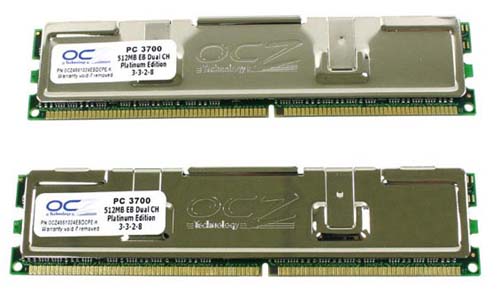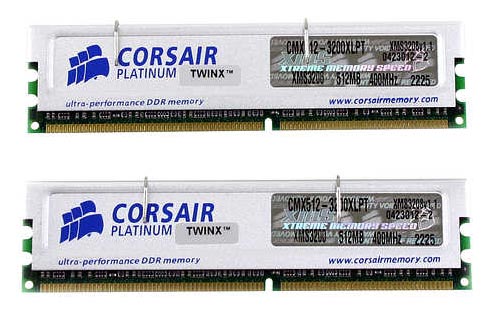Overclocking Buyer's Guide - August 2004
by Wesley Fink on July 27, 2004 11:24 AM EST- Posted in
- Guides
DDR Memory
DDR Recommendation: 1GB Kit (2 X 512MB) OCZ PC3700 EBPrice: $340 shipped

One of the advantages of the new AMD Socket 939 is that it uses regular unbuffered dual-channel memory. This means almost any memory will fit your new Socket 939 system. However, we have found that some memory perform much better in Athlon 64 systems than others, and the overall best Athlon 64 performance that we have found was with OCZ 3700EB, or Extended Bandwidth, memory.
The EB takes a little different approach to memory timings, and runs at 2.5-2-2, at DDR 400. This is still competitive with the best memory available, but by DDR433 to DDR450, the EB becomes the fastest memory that we have tested at that speed. Performance extends well beyond DDR500 and the performance at DR500 is the best that we have tested. Many Athlon 64 boards are picky about memory, but every Athlon 64 board that we have tested so far seems quite content with either 3700EB or 3500EB memory.
In the past year, OCZ has raised their Customer Service standards to among the best in the memory industry. We often get emails reporting very positive Customer Service and quick problem resolution when customers have contacted OCZ directly. OCZ combines that excellent Customer Service with a Lifetime Warranty.
DDR Alternative: 1GB Kit (2 X 512MB) Corsair 3200XL or 3200XL PRO
Price: $300 or $330 shipped

Corsair 3200XL roared on the scene in May with a return of 2-2-2 timings to DDR400. These fast timings were thought to be dead after Winbond discontinued their BH5 memory, but Corsair managed to return 2-2-2 to the market with a new generation of Samsung memory chips. The Corsair is an outstanding match to the alternate DFI 875B LANParty motherboard, and will provide the fastest DDR400 memory performance that you can currently find.
Corsair 3200XL also extends performance all the way to DDR500, so you will have incredible headroom when you select this memory for your system. The Corsair memory also works well on the AMD Athlon 64 platform when we tested it, but performance did not extend quite as far on the AMD platform. It is still a good choice for Athlon 64 machines where extremely high overclocking is not a top concern. While 2-2-2 memory based on Samsung chips is now available from OCZ, Kingston, and Mushkin; Corsair pioneered the return to 2-2-2 and was the first on the market with new memory capable of 2-2-2 timings.
Corsair is the standard by which every Enthusiast Memory manufacturer is measured, and their Customer Service is among the best in any industry. Corsair also provides a Lifetime Warranty on memory products and their "RAM Guy" is a well-known resource for memory problems in many Forums.
Either of these DDR recommendations will work very well on the MSI K8N Neo2, Asus P4C800-E Deluxe, or DFI NFII Ultra Infinity. However, DDR2 memory is required for the Asus P5AD2 Premium.
Listed below is part of our RealTime pricing engine, which lists the lowest prices available on DDR memory from many different reputable vendors:
If you cannot find the lowest prices on the products that we've recommended on this page, it's because we don't list some of them in our RealTime pricing engine. Until we do, we suggest that you do an independent search online at the various vendors' web sites. Just pick and choose where you want to buy your products by looking for a vendor located under the "Vendor" heading.










40 Comments
View All Comments
vaeren - Thursday, July 29, 2004 - link
Well I decided to try the EVGA card for 389 from www.buyxg.com Went to the site, lo and behold the card is stated there at 389. I go to buy it and it rings up 409. Ok, so I see it's backordered and I send them an e-mail basically asking them to honor the homepage. They essentially tell me that I don't know what I'm talking about and the page is now fixed. I don't think I'd recommend them in the future as an accurate price guideline. Granted Anandtech doesn't guarentee prices, but I think poor business practices should be addressed.PrinceGaz - Thursday, July 29, 2004 - link
Just a slight error in the article regarding the Mobile XP 2500+"However, the FSB speeds and multiplier are also a fortunate accident on the 2500+, since 11X is also the same multiplier as the top 3200+ Athlon XP. Since the 2500+ runs at 166 FSB, 3200+ performance is often as easy as setting the FSB to 200 from the default 166. Most, but not all, 2500+ can easily reach 3200+ speeds. The 2600+ mobile also looks even more promising as an overclocker, though we have not yet tested it. With specifications of the same 45 watt power consumption, a 12 multiplier, and 166FSB, it is hard not to be tempted when it is less than $10 more than a 2500+."
The desktop version of the 2500+ does run at 166*11 (1833 MHz), but the Mobile version has a 133FSB default. Thats not a problem because as you say in the article, they are unlocked so you can set the FSB and multiplier to whatever you like. But you will need to lower the multiplier with the Mobile 2500+ to run it as a 3200+.
The Mobile 2600+ is probably a much better choice because it has a much higher default speed than you'd expect,
Desktop 2500+ 166*11 = 1833 MHz
Desktop 2600+ 166*11.5 = 1917 MHz
Mobile 2500+ 133*14 = 1867 MHz (1.45V)
Mobile 2600+ 133*15 = 2000 MHz (1.45V)
the Mobile versions of both chips have a slightly higher clock speed than the desktop versions to compensate for the lower default FSB. In particular the Mobile 2600+ is a whole 133MHz faster than the Mobile 2500+ to compensate for the ever diminishing returns of higher multipliers.
For an overclocker that means the Mobile 2600+ is an unlocked chip that is guaranteed to run easily at 2GHz while still at 1.45V. That pretty much guarantees it will reach 2.3GHz, and maybe as much as 2.5GHz at the desktop 1.65V. And you can always give it a little extra juice if that isn't enough :)
roostercrows - Thursday, July 29, 2004 - link
#2 bluedarti did some research about a month ago on the synthetic diamond heatsinks and it seems they have been used for many decades (40+ years)."Swans" research was extremely helpful. i would like to know what material you are coating the diamonds on and also if you are infiltrating the diamonds with copper etc,(if you are makeing one you know what i mean). i have one ordered using tungsten and 6%cobalt as the base metal, 1mm to 1.5mm thick. i'm glad to hear someone else is playing around with this. btw, the specs that i looked at were 7x better than silver, using single crystal. also, what size are you using and are you using an existing product or are you starting from scratch? have fun.
Pathogen03 - Thursday, July 29, 2004 - link
I like the writting style and thought processes behind the review.. It definetly was the most fun, and most detailed one ive seen.BUT,
Your Recommendations are shaky at best. When you argued the 2500+ over the 2600+ for the mobile chip, it made sense, but the inclusion of the FX-53 over an Athlon64 just completely eludes me.. Id suggest you talk to some people on the forums before you do your next one, to doublecheck you have all of the current overclocking trends down. Oh, and a true overclocker would never even CONSIDER a Speeze heatsink.. If you want to talk about the article I can try to give you my opinion, you have my name in the forums just PM me.
TrogdorJW - Wednesday, July 28, 2004 - link
I have to say that this is by far the best of ANY of the guides that you and Evan have put together for Anandtech, Wesley. Perhaps it's the inclusion of four system options (with prices for all four, even!), or maybe it's just that I'm an overclocker at heart? Anyway, I'm not too sure about the FX-53 on the performance end, as it's just way too expensive, but that's about my only complaint. You mention the 3500+, and for the price, I would think that's the way to go.I have to agree with the suggestion of just making suggestions for the five basic platforms, though. I mean, you already have done that, with the exception of the socket 754 system. Add in a motherboard (MSI K8N Neo Platinum?) and CPU (3200+ 1 MB?), and you're pretty much done.
Anyway, great job! I'm seriously looking at a socket 754 overclocking setup in the near future, unless someone can convince me that the extra $120 for the 3500+ over the 3200+ (not to mention the motherboard probably costing ~$40 more for S939) is worthwhile. Any takers, or should I just go with a 3200+? I won't be buying for at least another month, Wesley, so you can address my needs in your next OC guide! :)
Wesley Fink - Wednesday, July 28, 2004 - link
MSI just sent the following reply to our request for information about when the K8N Neo2 would be available for purchase by our readers:"I am sorry for this kind of situation and inconvenience. My first shipment of K8N Neo2 will be this coming Tue. (Aug 3rd). Most on-line etailers (newegg, ziproomfly, .......) will post the board on Wed. or Thu to allow customers to buy it.
We will also modify the product page from "available soon" to "first week of AUG." http://www.msicomputer.com/product/p_spec.asp?mode..."
Parc - Wednesday, July 28, 2004 - link
Great article as always. These are my favorite because it is exactly what I look to your website for the best of the hardware out. Key word out. The MSI board is not out and now had been delayed to somewhere around August 9. By August 9 the board will probably be delayed again. Why do you keep putting a board up that no one can get? The 6800s are hard to get but can be gotten . This just a suggestion. Still great article except board.Wesley Fink - Wednesday, July 28, 2004 - link
The Coolermaster CM stacker is not an all-Aluminum case, but a mixture of 1.0 mm steel plate for strength and Aluminum alloy. The description has been corrected in the article.Anemone - Wednesday, July 28, 2004 - link
Agreed Shinei...I'm looking at the 3700 EB (3-3-2-8) and then at the new 4000 Rev 2 (2.5-3-3-?) and curious how they compare. Had a chance to look over the new 4000 Rev 2 yet Wesley?
Loved this article totally - as well as the 939 reviews. OC'ing on the new 925X boards has a host of connected issues with pci-e and sata, so bye bye Intel...
Another great AT article for sure
Shinei - Wednesday, July 28, 2004 - link
T8000 has apparently never read any of the Socket 939 benchmarks AT did, or he'd know that the AFX's stomp out Intel at media encoding (along with just about everything else). Anyway, moving on from Trollville.I agree about the 3500+ being the better price/performance part over the FX53. Of course, I don't own one, so I can't comment on performance, but based on AT's results, it looks like a promising component...